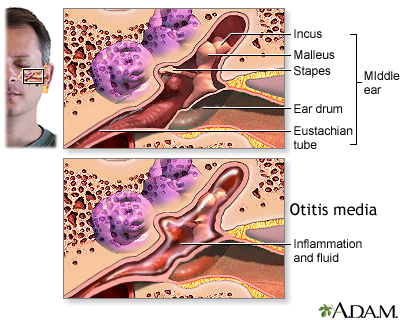| Otitis media (middle ear infection) |
The term "otitis media" means inflammation of the middle ear, usually due to colds or allergies. The inflammation often leads to ear infections. Otitis media is a common childhood illness that usually requires a doctor's visit. In adults, it is a less frequent but quite disabling cause of ear pain.
Otitis media occurs most often among infants and young children because their inner ears are less developed and at an angle where bacteria, viruses, and other irritants can easily enter through the throat. Otitis media is often accompanied by a stuffy, runny nose. Many children get acute cases that go away within a few days after treatment with antibiotics. Some children, however, get recurring bouts of otitis media. This can lead to the build-up of middle ear fluid (otitis media with effusion). Children who have recurrent or chronic otitis media with fluid build-up may experience difficulty hearing, which can lead to problems with speech and language development later on.

Symptoms
Early signs of otitis media are ear pain and discomfort. Children may have trouble sleeping, lose their appetite, or show signs of irritability. Other symptoms include hearing loss, snoring, mouth breathing, fever, headache, vomiting, and diarrhea.
Causes
The Eustachian (pharyngotympanic) tube is a drain that connects the nose and throat to the middle ear. It allows fluids from the ear to drain down the back of the throat, and keeps pressure equal on both sides of the eardrum. When the tube becomes blocked, either by swelling, inflammation, or mucus, fluid in the middle ear can accumulate and an infection can develop. People with chronic ear infections usually have allergies that play a key role in blocking the Eustachian tube.
Other factors that can lead to otitis media include exposure to cigarette smoke, cold or flu (which are especially common in day care centers), bottle-feeding while lying down, and pre-existing upper respiratory conditions.
Diagnosis
The doctor will ask detailed questions about your child's symptoms, previous ear infections, family history of allergies, and potential exposure to environmental allergens.
The doctor will then examine your child's ears with an otoscope, which allows the doctor to see the eardrum and look for inflammation and fluid build-up.
Management
Early treatment and prevention of otitis media is important, because of the associated hearing loss.
Some cases of otitis media require antibiotic treatment, but many do not. An acute ear infection deserves pain relief, either from oral medicines or from ear drops. If your child has recurrent otitis media due to bacterial infection, the doctor may recommend giving antibiotics as a preventive precaution. If your child's recurrent or chronic otitis media continues to be a problem, the doctor may refer you to an ear, nose and throat specialist who can discuss surgical remedies like insertion of tubes in the ears or removal of the adenoid glands.
 | Click the icon to see an illustrated series explaining the insertion of an ear tube. |
If the doctor finds that your child's symptoms are caused by allergies, the doctor may refer you to an allergist who can then recommend steps to prevent symptoms, such as allergen avoidance, allergy medication, or immunotherapy.
Reference
American Academy of Pediatrics Subcommittee on Management of Acute Otitis Media. Diagnosis and management of acute otitis media. Pediatrics. 2004 May;113(5):1451-65.
Ramakrishnan K, Sparks RA, Berryhill WE. Diagnosis and treatment of otitis media. Am Fam Physician. 2007 Dec 1;76(11):1650-8.
Teschke R, Schulze J. Risk of kava hepatotoxicity and the FDA consumer advisory. JAMA. 2010;304(19):2174-2175.
Wald ER. Acute otitis media and acute bacterial sinusitis. Clin Infect Dis. 2011;52(suppl 4):S277-S283.
Reviewed By: Paula J. Busse, MD, Assistant Professor of Medicine, Division of Clinical Immunology, Mount Sinai School of Medicine, New York, NY, Review provided by VeriMed Healthcare Network. Also reviewed by David Zieve, MD, MHA, Medical Director, A.D.A.M., Inc.
